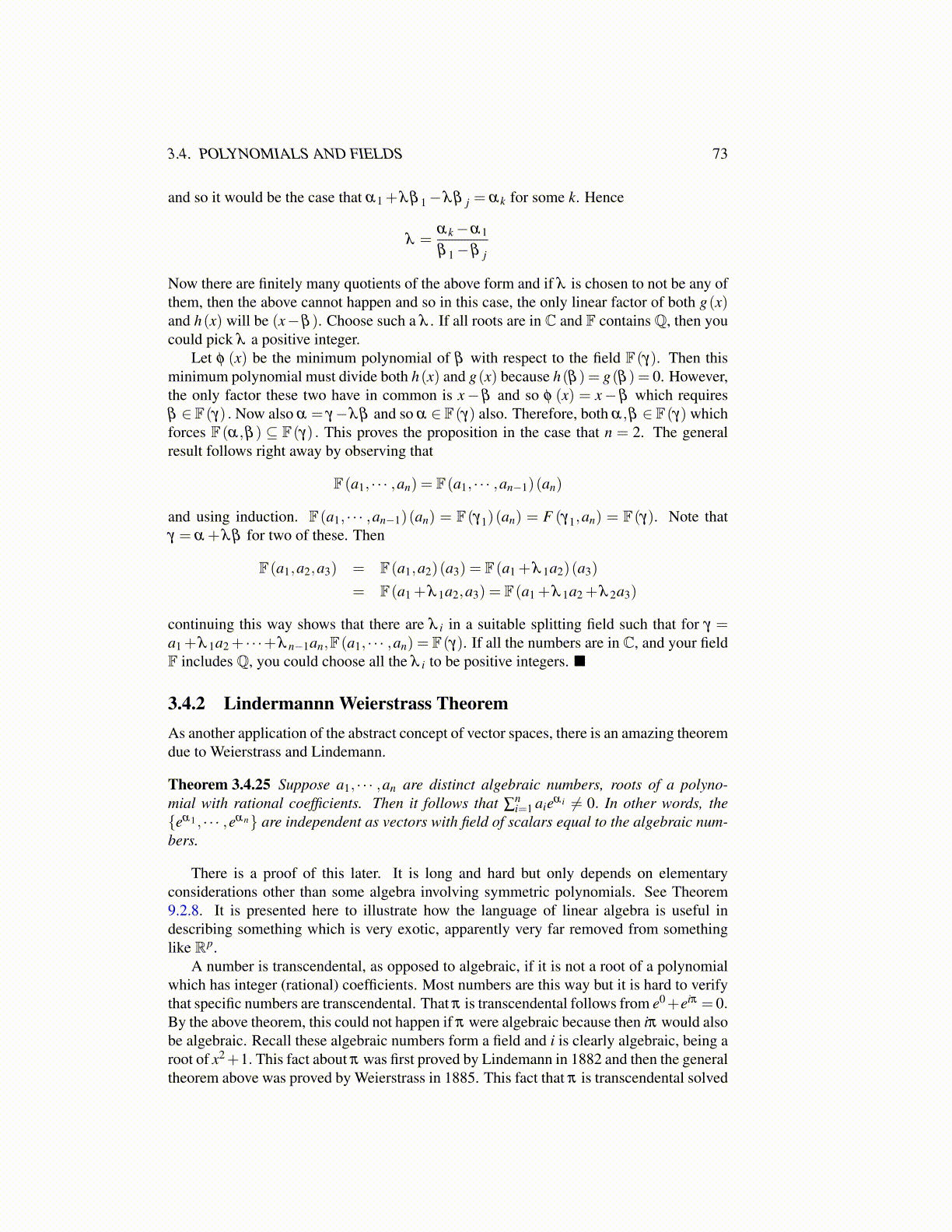
3.4. POLYNOMIALS AND FIELDS 73
and so it would be the case that α1 +λβ 1−λβ j = αk for some k. Hence
λ =αk−α1
β 1−β j
Now there are finitely many quotients of the above form and if λ is chosen to not be any ofthem, then the above cannot happen and so in this case, the only linear factor of both g(x)and h(x) will be (x−β ). Choose such a λ . If all roots are in C and F contains Q, then youcould pick λ a positive integer.
Let φ (x) be the minimum polynomial of β with respect to the field F(γ). Then thisminimum polynomial must divide both h(x) and g(x) because h(β ) = g(β ) = 0. However,the only factor these two have in common is x− β and so φ (x) = x− β which requiresβ ∈ F(γ) . Now also α = γ−λβ and so α ∈ F(γ) also. Therefore, both α,β ∈ F(γ) whichforces F(α,β ) ⊆ F(γ) . This proves the proposition in the case that n = 2. The generalresult follows right away by observing that
F(a1, · · · ,an) = F(a1, · · · ,an−1)(an)
and using induction. F(a1, · · · ,an−1)(an) = F(γ1)(an) = F (γ1,an) = F(γ). Note thatγ = α +λβ for two of these. Then
F(a1,a2,a3) = F(a1,a2)(a3) = F(a1 +λ 1a2)(a3)
= F(a1 +λ 1a2,a3) = F(a1 +λ 1a2 +λ 2a3)
continuing this way shows that there are λ i in a suitable splitting field such that for γ =a1 +λ 1a2 + · · ·+λ n−1an,F(a1, · · · ,an) = F(γ). If all the numbers are in C, and your fieldF includes Q, you could choose all the λ i to be positive integers. ■
3.4.2 Lindermannn Weierstrass TheoremAs another application of the abstract concept of vector spaces, there is an amazing theoremdue to Weierstrass and Lindemann.
Theorem 3.4.25 Suppose a1, · · · ,an are distinct algebraic numbers, roots of a polyno-mial with rational coefficients. Then it follows that ∑
ni=1 aieα i ̸= 0. In other words, the
{eα1 , · · · ,eαn} are independent as vectors with field of scalars equal to the algebraic num-bers.
There is a proof of this later. It is long and hard but only depends on elementaryconsiderations other than some algebra involving symmetric polynomials. See Theorem9.2.8. It is presented here to illustrate how the language of linear algebra is useful indescribing something which is very exotic, apparently very far removed from somethinglike Rp.
A number is transcendental, as opposed to algebraic, if it is not a root of a polynomialwhich has integer (rational) coefficients. Most numbers are this way but it is hard to verifythat specific numbers are transcendental. That π is transcendental follows from e0+eiπ = 0.By the above theorem, this could not happen if π were algebraic because then iπ would alsobe algebraic. Recall these algebraic numbers form a field and i is clearly algebraic, being aroot of x2+1. This fact about π was first proved by Lindemann in 1882 and then the generaltheorem above was proved by Weierstrass in 1885. This fact that π is transcendental solved